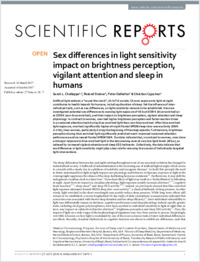Sex differences in light sensitivity impact on brightness perception, vigilant attention and sleep in humans.
- Chellappa SL Medical Chronobiology Program, Division of Sleep and Circadian Disorders, Departments of Medicine and Neurology, Brigham and Women's Hospital, Boston, MA, USA. schellappa@bwh.harvard.edu.
- Steiner R Department of Physics, University of Basel, Basel, Switzerland.
- Oelhafen P Department of Physics, University of Basel, Basel, Switzerland.
- Cajochen C Centre for Chronobiology, Psychiatric Hospital of the University of Basel, Transfaculty Research Platform Molecular and Cognitive Neurosciences, University of Basel, Basel, Switzerland. Christian.Cajochen@upkbs.ch.
- 2017-10-29
Published in:
- Scientific reports. - 2017
Adult
Arousal
Attention
Electroencephalography
Female
Humans
Light
Male
Photophobia
Sex Characteristics
Sleep
Visual Perception
Young Adult
English
Artificial light endows a "round-the-clock", 24-h/7-d society. Chronic exposure to light at night contributes to health hazards for humans, including disorders of sleep. Yet the influence of inter-individual traits, such as sex-differences, on light sensitivity remains to be established. Here we investigated potential sex-differences to evening light exposure of 40 lx at 6500 K (blue-enriched) or at 2500 K (non-blue-enriched), and their impact on brightness perception, vigilant attention and sleep physiology. In contrast to women, men had higher brightness perception and faster reaction times in a sustained attention task during blue-enriched light than non-blue-enriched. After blue-enriched light exposure, men had significantly higher all-night frontal NREM sleep slow-wave activity (SWA: 2-4 Hz), than women, particularly during the beginning of the sleep episode. Furthermore, brightness perception during blue-enriched light significantly predicted men's improved sustained attention performance and increased frontal NREM SWA. Our data indicate that, in contrast to women, men show a stronger response to blue-enriched light in the late evening even at very low light levels (40lux), as indexed by increased vigilant attention and sleep EEG hallmarks. Collectively, the data indicate that sex differences in light sensitivity might play a key role for ensuring the success of individually-targeted light interventions.
- Language
-
- English
- Open access status
- gold
- Identifiers
-
- DOI 10.1038/s41598-017-13973-1
- PMID 29079823
- Persistent URL
- https://folia.unifr.ch/global/documents/202280
Statistics
Document views: 32
File downloads:
- fulltext.pdf: 0
